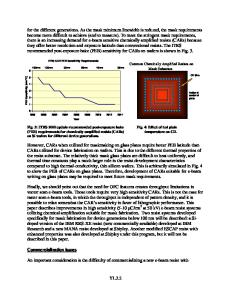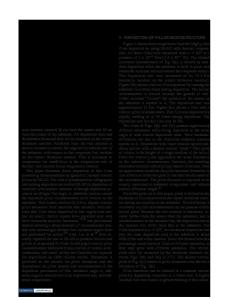Spm Based Lithography for Nanometer Scale Electrodes Fabrication
- PDF / 2,638,723 Bytes
- 6 Pages / 417.6 x 639 pts Page_size
- 94 Downloads / 395 Views
1
Osservatorio Astronomico di Roma, Monteporzio Catone, Italy E-mail: [email protected] ABSTRACT Scanning probe assisted nanolithography is a very attractive technique in terms of low-cost, patterning resolution and positioning accuracy. Our approach makes use of a commercial atomic force microscope and silicon probes to build simple nanostructures, such as metal electrode pairs, for application in novel quantum devices. Sub-100 nm patterning was successfully performed using three different techniques: direct material removal, scanning probe assisted mask patterning and local oxidation. INTRODUCTION In recent years there has been an increasing interest in both standard and unconventional nanofabrication techniques for the development of nanodevices to be used in fundamental physics as well as in applied research. Novel devices will require a circuit patterning resolution and a positioning accuracy ranging beyond the limits of the present fabrication processes. A possible solution is the integration of conventional lithography with scanning probe microscopy (SPM) based techniques allowing the definition of circuit patterning down to a nanometer scale. Applying different principles, several attempts were made using SPM to induce modification of insulators, semiconductors and metals on the nanometer scale: low-energy exposure of resists
[1], thermo-mechanical writing [2], local oxidation [3,4], mechanical modification [5]. We report here a study on the nanolithographic capabilities of the atomic force microscope (AFM), which takes advantage of the imaging facility and the ability of moving a probe over the sample surface in a controllable way. Our goal is to achieve sub-100 nm patterning definition for the fabrication of metallic nanoelectrode pairs. EXPERIMENTS AND RESULTS A Digital Instruments D3100 AFM operating in ambient air was used for both processing and imaging. The nanolithographic steps were made with both commercial and home-made silicon probes. In the following we describe the techniques used to fabricate metallic nanoelectrode pairs. Direct Material Removal Our first approach to nanolithography was the direct modification induced by scratching a sample. Indeed it is possible to remove material from a metal stripe by applying an amount of force of several liN [6]. The samples we used were aluminum stripes patterned on an oxidized silicon wafer by standard electron-beam lithography (fig. 1(a)). 319
Mat. Res. Soc. Symp. Proc. Vol. 584 © 2000 Materials Research Society
In order to directly remove the material we had to use high spring constant cantilevers.1 Commercial silicon probes are available with spring constant values between 20 and 100 N mand a tip radius - 10 nm. This type of cantilevers is not suitable for imaging in contact-mode. However, an accurate control of the scanning parameters allowed us a proper alignment to the scratching site before processing, without a significant wear of the sample. The scratches were made at a rate of 0.1 psm s-1, having found that different rate values
Data Loading...











